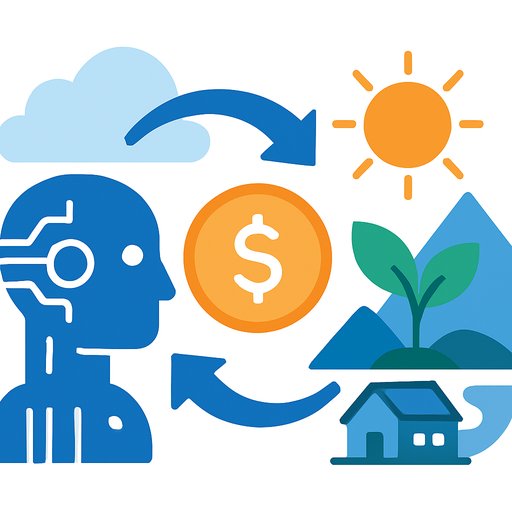Fund resilience, not disasters: how finance can use AI to price climate and nature risk
In 2024, the World Meteorological Organization recorded 617 extreme weather events. Of these, 152 were unprecedented and 297 were unusual, displacing more than 824,000 people, injuring 1.1 million, and causing 1,700 fatalities. The direct and indirect costs are eroding growth in the most exposed regions. For finance teams, this is a pricing problem and a capital allocation problem.
The International Day for Disaster Risk Reduction calls for one thing: fund resilience, not disaster relief. That means moving beyond post-event payouts and building risk into valuations, cash flows, and terms today.
Why climate, biodiversity, and land risks are material
Wetlands, forests, and soils provide services that reduce losses and stabilize local economies. Their degradation increases hazard exposure and weakens collateral quality. Recent analyses show nature loss carries significant balance-sheet risk for banks and investors. Ignoring these drivers keeps adaptation costs compounding and pushes critical investments further out of reach.
Where AI adds real value
- Early, decision-ready risk signals: AI can process satellite data, climate reanalysis, and asset-level exposure to flag hotspots across portfolios.
- Improved extremes predictability: Models now detect hidden drivers of heatwaves and improve cyclone track and intensity forecasts-useful for underwriting, hedging, and stress testing.
- Nature risk quantification: Initiatives like AlphaEarth Foundations fuse Earth observation and climate data to map land degradation, deforestation, and soil health-converting environmental change into financial inputs.
- Operational insights: Machine learning has identified heightened fire susceptibility in monoculture forests, guiding forestry management, insurance pricing, and resilience CAPEX.
From relief to resilience: translate CBL risk into finance metrics
To steer capital, climate-biodiversity-land (CBL) data must flow into valuation, credit, and insurance models. AI can convert messy, high-frequency datasets into metrics your ICs and risk committees use.
- Credit risk: Adjust PD/LGD with asset-level hazard, exposure, and vulnerability scores; update collateral haircuts and covenants.
- Cash flow stability: Model avoided losses from nature-based solutions (e.g., mangroves cutting storm surge damage) to improve DSCR and insurance costs.
- Insurance design: Calibrate parametric triggers with real-time signals to speed payouts and lower basis risk.
- Sovereign/municipal risk premia: Price forward exposure to heat, drought, flood, and land degradation into spreads and maturities.
Portfolio playbook: build, prove, scale
- Data stack: Combine EO/sensor data, climate projections, and financial exposures in a shared environment with clear data lineage and versioning.
- Model selection: Use a mix of time-series, geospatial, and causal approaches; benchmark against baselines; monitor drift.
- Explainability by default: Require feature attribution, counterfactuals, and clear uncertainty ranges so decisions can be audited and defended.
- Controls and disclosure: Align with existing climate and nature risk frameworks; document assumptions, coverage, and gaps.
- Blended finance targeting: Use AI to locate projects where public funds best de-risk private capital and crowd in scale.
Funding instruments AI can upgrade
- Resilience-linked bonds: KPI structures tied to quantifiable hazard reduction or ecosystem restoration, verified with satellite and sensor data.
- Project finance for nature-based solutions: Cash flow models incorporate avoided-loss benefits and premium reductions.
- Cat bonds and parametric covers: Trigger design and pricing informed by high-resolution, near-real-time data.
- SME credit lines: Sector- and region-specific climate signals guide pricing and technical assistance for climate-smart agriculture.
Make AI accessible and trustworthy
- Shared infrastructure: Equitable access to standardized, high-quality data and compute-within and across institutions.
- Model transparency: Explainable AI (xAI) grounded in physical science and expert knowledge to justify investment and underwriting calls.
- Governance: Clear ownership, validation, red-teaming, and audit trails; periodic third-party reviews; controls for bias and misuse.
International coordination matters
Global collaboration can speed standards and reduce duplication. The Global Initiative on Resilience to Natural Hazards through AI Solutions and its Working Group on AI for Climate Applications focus on practical mitigation and adaptation, including for developing countries and small island states.
Explore authoritative resources: the World Meteorological Organization for climate risk context and ITU's AI for Good for initiatives and guidance.
What to do this quarter
- Run a pilot: one hazard, one asset class, one region. Define clear success metrics (loss reduction, pricing accuracy, time-to-decision).
- Procure data and models with xAI and audit requirements baked into contracts.
- Embed outputs in actual decisions: credit terms, insurance pricing, or capex approvals-not just dashboards.
- Set a resilience allocation target and track it like any other mandate.
- Structure a blended finance tranche where early public capital de-risks a nature-based project with measurable outcomes.
Skill up your team
If your finance team needs practical tools to work with AI in risk, underwriting, and investment workflows, explore curated options here: AI tools for finance.
Capital will always chase clarity. Use AI to turn climate and nature risk into clear metrics, then fund the projects that cut those risks at the source.
Your membership also unlocks:






